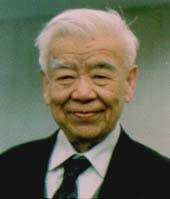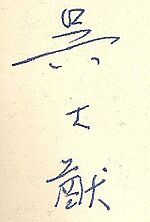Wu Ta-You facts for kids
Quick facts for kids
Wu Ta-You
|
|
|---|---|
| 吴大猷 | |
 |
|
| Born | 27 September 1907 Panyu, Guangzhou, Qing Dynasty
|
| Died | 4 March 2000 (aged 92) |
| Nationality | Republic of China |
| Alma mater | Nankai University (UG) University of Michigan (MS, PhD) |
| Scientific career | |
| Fields | Nuclear physics Atomic physics |
| Notable students | Chen Ning Yang Tsung-Dao Lee |
| Signature | |
 |
|
Wu Ta-You (simplified Chinese: 吴大猷; traditional Chinese: 吳大猷; pinyin: Wú Dàyóu) was a very important Chinese physicist and writer. He was born on September 27, 1907, and passed away on March 4, 2000. He worked in many different places, including the United States, Canada, mainland China, and Taiwan. Many people called him the "Father of Chinese Physics" because of his big impact on science.
Contents
Early Life and Education
Wu Ta-You was born in Panyu, a part of Guangzhou, China. This was during the last years of the Qing dynasty, a very old time in Chinese history.
In 1929, he finished his first degree at Nankai University in Tianjin. After that, he moved to the United States to continue his studies. He earned a special degree called a Doctor of Philosophy (PhD) from the University of Michigan in 1933.
Wu Ta-You's Career
After getting his PhD, Wu Ta-You went back to China. From 1934 to 1949, he taught at several universities. These included Peking University in Beijing and National Southwestern Associated University in Kunming.
When the Chinese Civil War ended in 1949, Wu moved to Canada. There, he led the Theoretical Physics Division at the National Research Council of Canada. He worked there until 1963.
In the 1960s, he became the head of the Physics and Astronomy Department at the University at Buffalo in the U.S. After 1962, he also held many important jobs in Taiwan. He was even the President of the Academia Sinica from 1983 to 1994. Wu Ta-You kept teaching even when he was in his 90s! He passed away on March 4, 2000.
His Work in Physics
Wu Ta-You's PhD work was about predicting the chemical properties of elements that had not yet been found. These were called transuranic elements, like plutonium and americium.
Later in his career, he studied many areas of theoretical physics. This included solid-state physics, which looks at how solid materials behave. He also worked on molecular physics and statistical physics.
Wu was known for being a great teacher as much as a scientist. Two of his most famous students were Chen Ning Yang and Tsung-Dao Lee. They both won the Nobel Prize in Physics in 1957!
Books by Wu Ta-You
Wu Ta-You also wrote several books. One of his most famous books is Vibrational Spectra and Structure of Polyatomic Molecules (1939). He also wrote textbooks for advanced students, like Quantum Mechanics (1986). He co-wrote another book called Relativistic Quantum Mechanics and Quantum Fields (1991).
Awards and Special Recognitions
Wu Ta-You's contributions to science are still remembered today.
- Since 2002, the Ministry of Science and Technology in Taiwan gives out the Wu Ta-You Memorial Award every year. This award honors new scientists.
- The Physics Department at the University at Buffalo hosts a special event called the Ta-You Wu Lecture.
- The Physics Department at the University of Michigan also hosts a Ta-You Wu Lecture.
- An asteroid in space, named 256892 Wutayou, was discovered in 2008. It was named after him to remember his amazing work!

